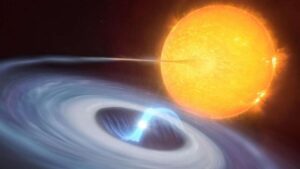APRIL 23, 2022

Bengaluru: Astronomers in Europe have observed a new kind of stellar explosion for the first time, called ‘micronova’, according to results published in the journal Nature.
This is a phenomenon where there are localised fusion reactions expelling energy and matter on the surface of the star, mainly confined to the poles.
Unlike a supernova, a micronova does not result in the destruction of the star. Rather, it occurs when a white dwarf is feeding on the material of another star. Provided the white dwarf has a strong magnetic field, all the accreted matter gets funnelled to the magnetic poles, where a runaway thermal fusion reaction occurs.
Since the reactions and explosions are much lower in magnitude as compared to a supernova or a nova (explosions all over the surface of a white dwarf), the team of astronomers named these reactions micronovae.
Despite the name ‘micro’, the reactions are extremely powerful, occurring at the poles of highly magnetic dense white dwarfs, capable of wiping out planets.
The reactions are very transient and the explosions last mere hours, making them difficult to spot as they occur. The team discovered the first micronova while combing through data from NASA’s Transiting Exoplanet Survey Satellite (TESS) surveys, and subsequently searched for and discovered two more.
While two were from previously identified white dwarfs, the third explosion needed to be confirmed as originating in one. European Southern Observatory’s Very Large Telescope (ESO’s VLT) array confirmed that all three explosions originated at the poles of white dwarfs.
The findings indicate that such micronovae could actually be quite common in the universe, and within our own galaxy, but have been hard to spot as they are so short-lived.
Types of stellar explosions
There are many known types of stellar or star explosions.
A supernova is the most well-known and is one of the most energetic events that occur in the universe. Supernovae are of two kinds: In one, a star much more massive than our Sun runs out of fuel and elements to fuse. It then collapses under its own gravity and implodes, blowing off its outer layers and leaving a dense remnant which is usually a neutron star or a black hole.
In another kind of supernova, which occurs in binary star systems containing at least one white dwarf, the white dwarf starts to gravitationally attract matter from the other star (or less massive white dwarf). This accretion of matter provides enough material for fusion to kickstart again, resulting in a runaway thermonuclear reaction and a subsequent supernova.
A white dwarf itself is formed when a star that doesn’t have enough mass to explode in a supernova sheds its outer layers and compacts into the dense object at the end of its fusion stage. Our Sun is expected to go this way billions of years into the future, without a supernova.
White dwarfs, neutron stars, and black holes are classified as compact objects, and are formed after a star undergoing thermonuclear fusion runs out of fuel and ‘dies’.
A hypernova is an extremely energetic supernova, resulting from a star with over 30 times the mass of our Sun running out of fuel. Its core collapses and the remnant is typically a powerful, rotating black hole, with energetic jets coming out of its poles.
In 2017, astronomers spotted a kilonova, when two neutron stars collided. Kilonovae are not bright in the visible spectrum but glow brightly in other parts of high energy spectra. They are recorded on Earth as gravitational waves and occur when a binary system comprising at least one neutron star, and another neutron star or black hole, collide.
These kinds of extremely powerful explosions result in the death of the progenitor or original body, and release large quantities of heavy metals like uranium, europium, selenium, ruthenium, gold, platinum, etc, at nearly one-fifth the speed of light. Powerful explosions like kilonovae also release deadly gamma-ray bursts, beams of targeted gamma rays capable of wiping out all life if pointed directly at Earth.
Beyond stellar death, there are other explosions as well. A luminous red nova occurs when two stars collide, a failed supernova is also not uncommon, and a supernova imposter is where the progenitor does not die.
Novae and micronovae
A nova is a name for a transient or temporary astronomical phenomenon that appears like a bright new star and fades after a few days, weeks, months, or years.
Novae occur in binary star systems with a white dwarf.
As the two bodies circle each other, and the white dwarf starts to feed on the matter from its companion star, the matter spreads on its surface, leading to thermonuclear fusion reactions occurring on the surface of the white dwarf. These reactions occur globally but are not powerful enough to trigger a supernova because not enough matter has been accreted.
These runaway reactions on the surface of the star eject matter and form an atmosphere, leading it to glow and cause the appearance of a nova. The matter ejected is substantially less in quantity as compared to a supernova and originates only from the surface.
Novae have been known to last a couple of hundred years as well, as a white dwarf continues to feed on its companion star.
Micronovae occur on white dwarfs with strong magnetic fields, capable of moving all incoming accreting material to the poles and confining the reactions there.
Courtesy/Source: The Print









































































































